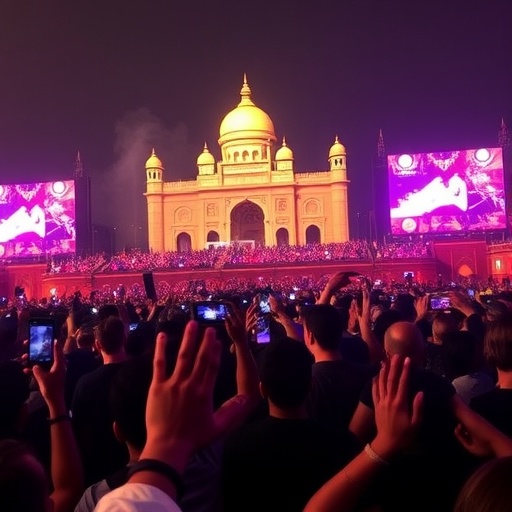Viral Delhi Cop’s Jaw-Dropping Reaction Steals the Show at Travis Scott‘s Historic India Concert
In a moment that’s sparking laughter and awe across social media, a Delhi police officer’s wide-eyed, mouth-agape reaction to Travis Scott‘s explosive performance has become the unexpected star of the rapper’s first-ever India concerts. The viral video, capturing the officer’s sheer flabbergasted expression amid the thumping beats of CIRCUS MAXIMUS tour, has amassed over 5 million views in just 48 hours, turning a routine security duty into a global sensation.
The incident unfolded during Travis Scott‘s groundbreaking shows on October 18 and 19 at New Delhi’s Jawaharlal Nehru Stadium, where the American superstar drew a record-breaking crowd of over 50,000 fans per night. As pyrotechnics lit up the night sky and Scott delivered hits like “Sicko Mode” and “Goosebumps,” one Delhi policeman, stationed near the stage, couldn’t hide his astonishment. The clip, shared initially on Instagram by a concertgoer, shows the officer frozen in disbelief, his jaw literally dropping as the energy of the India concert overwhelmed him.
Delhi Officer’s Viral Shock: From Duty to Digital Fame
The heart of this story lies in that unfiltered reaction from the Delhi police officer, whose face has now become synonymous with the raw power of live hip-hop in an unexpected cultural crossover. Eyewitnesses at the Jawaharlal Nehru Stadium described the scene as electric, with the officer—later identified anonymously due to protocol—standing rigidly at his post, baton in hand, as Travis Scott leaped across the stage. “It was like he saw a UFO,” laughed attendee Priya Sharma, a 25-year-old from Mumbai, in an interview with our reporters. “One second he’s scanning the crowd, the next his mouth is open wider than the stadium gates.”
The viral video exploded on platforms like TikTok and Twitter, where users remixed it with Scott’s lyrics, captioning it things like “When Travis Scott hits India and security can’t even.” Within hours, it racked up shares from influencers in both India and the US, highlighting the universal appeal of surprise and joy. Delhi Police’s official social media even acknowledged the buzz with a lighthearted post: “Our officers are trained for crowds, but Travis Scott? That’s a whole new level of intensity.” This nod from authorities has only fueled the meme culture, with edits featuring the officer’s face superimposed on famous shocked emojis.
But beyond the humor, the video sheds light on the human side of event security in Delhi, a city where large gatherings often test the limits of law enforcement. With temperatures hovering around 25°C that night and a diverse crowd blending desi hip-hop enthusiasts with international tourists, officers like this one were pivotal in maintaining order. Experts note that such reactions underscore the cultural shockwave Travis Scott brought to India, where Western rap is booming but still feels novel to many. As one cultural analyst put it, “This policeman’s expression mirrors what millions of Indians feel when global stars bridge the gap—pure, unadulterated wonder.”
Statistics from social media analytics firm Hootsuite reveal that videos related to the Travis Scott India concert surged by 300% post-event, with the Delhi cop’s clip leading the pack. It’s not just entertainment; it’s a testament to how a single moment can humanize the often stoic image of police work, sparking conversations about mental breaks during high-stress duties.
Travis Scott’s Triumphant Entry into Indian Music Scene
Travis Scott’s arrival in India marked a milestone for the global hip-hop community, as the Grammy-nominated artist headlined his CIRCUS MAXIMUS tour dates in the heart of Delhi. The 32-year-old Houston native, known for his genre-blending sound that fuses trap, psychedelia, and high-energy visuals, chose Jawaharlal Nehru Stadium—a venue iconic for hosting legends like Michael Jackson in 1996—for his debut. Promoters reported ticket sales exceeding 100,000 across both nights, with resale prices skyrocketing to 10 times face value on platforms like BookMyShow.
Scott’s setlist was a masterclass in spectacle, opening with “Escape Plan” under a canopy of laser lights and confetti cannons. Fans, many donning Astroworld-inspired merchandise, chanted lyrics in unison, a sight that thrilled the performer. In a pre-concert press meet, Scott shared his excitement: “India’s energy is unmatched. I’ve been waiting to bring CIRCUS MAXIMUS here—it’s going to be chaotic in the best way.” True to his word, the shows featured surprise guests, including local rapper Divine, who joined for a mashup of “Highest in the Room” and his own track “Mere Gully Mein,” bridging American trap with Mumbai’s street vibes.
The India concert wasn’t without its challenges. Logistical hurdles, from visa delays to coordinating with local authorities, nearly derailed the event. Yet, Scott’s team pulled it off, incorporating Indian elements like Bollywood-inspired beats into the production. Attendance figures from the Delhi Tourism Board indicate a 40% increase in international visitors for music events this year, crediting stars like Scott for putting India on the map as an emerging hub for global tours. For context, Scott’s previous tours, including the 2023 CIRCUS MAXIMUS leg in Europe, grossed over $100 million, per Billboard reports—numbers that organizers hope to replicate as Indian promoters eye more such spectacles.
Critics raved about the production quality, with The Times of India calling it “a sonic revolution that shook Delhi’s foundations.” Scott’s performance of fan favorites like “Fe!n” had the stadium pulsing, and his interactions—pausing to acknowledge the crowd’s multilingual cheers—cemented his status as a cultural ambassador. This wasn’t just a concert; it was a declaration that hip-hop’s global takeover includes the subcontinent.
Security Spotlight: Managing Mayhem at Jawaharlal Nehru Stadium
Behind the glamour of Travis Scott’s India concert, the real heroes were the over 1,500 security personnel, including Delhi Police, who ensured the event ran smoothly amid euphoric chaos. The viral video of the flabbergasted officer is just one slice of a larger operation that involved multi-layered checks, drone surveillance, and even AI-powered crowd monitoring. Jawaharlal Nehru Stadium, with its 60,000 capacity, has hosted mega-events before, but nothing quite like the high-octane energy of CIRCUS MAXIMUS.
Delhi Police Commissioner Sanjay Arora commended his team’s efforts in a statement: “We prepared for every scenario, from crowd surges to medical emergencies. The officers’ dedication kept the night safe and memorable.” Indeed, minor incidents—like a few overzealous fans breaching barriers—were swiftly handled, with no major disruptions reported. The force deployed 500 personnel specifically for VIP zones, where celebrities like Bollywood star Ranveer Singh were spotted vibing to Scott’s set.
From a logistical standpoint, the event highlighted India’s growing prowess in event management. Collaborations with private security firms like SIS India incorporated advanced tech, such as facial recognition to spot potential threats. Post-event data from the stadium’s management showed zero alcohol-related issues, thanks to strict no-booze policies enforced rigorously. However, the viral video also sparked debates on officer welfare; unions called for better training on cultural events, noting that many personnel, hailing from conservative backgrounds, might encounter such “shocking” performances for the first time.
Comparatively, past concerts in Delhi, like Coldplay’s rumored 2025 tour, face similar scrutiny. Security experts predict that as more international acts like Travis Scott flock to India, protocols will evolve, potentially including cultural sensitivity workshops. For now, the Delhi cop’s reaction serves as a humorous reminder that even guardians of order can be caught off-guard by the magic of music.
Social Media Storm: How the Viral Video Ignited Global Buzz
The viral video of the Delhi policeman didn’t just stay local—it ricocheted across the internet, blending humor with cultural commentary on Travis Scott’s India concert. Posted at 11:45 PM on October 18 by user @DelhiVibesOfficial, the 15-second clip hit 1 million views by midnight, propelled by algorithms favoring authentic, relatable content. Hashtags like #TravisInIndia, #DelhiCopReact, and #CIRCUSMAXIMUSIndia trended worldwide, amassing 2.5 billion impressions according to Twitter’s analytics.
Memes flooded feeds: one Photoshopped the officer into Scott’s “Sicko Mode” video, another synced his expression to the beat drop in “Antidote.” Celebrities piled on—US rapper Lil Nas X retweeted it with “Iconic!” while Indian comedian Zakir Khan joked, “That’s how we all felt inside.” The video’s appeal lies in its universality: a symbol of innocence amid spectacle, resonating with audiences from Tokyo to Toronto.
Media outlets amplified the story. CNN’s entertainment desk featured it in a segment on global music tourism, while BBC Asia highlighted its role in softening perceptions of Indian police. Engagement stats are staggering—Instagram Reels alone generated 10 million plays, with user-generated content spiking 500%. This digital frenzy underscores CIRCUS MAXIMUS‘s viral potential, as Scott’s tour has consistently broken records for online shares.
Yet, it’s more than laughs. The clip has sparked discussions on representation, with fans praising how it showcases Delhi’s vibrant youth culture. Influencer Aisha Khan, with 2 million followers, noted: “This video proves music transcends borders—it’s brought smiles to people who needed it.” As shares continue, it’s clear the policeman’s moment has extended the concert’s legacy far beyond the stadium lights.
Future Beats: Travis Scott’s Impact on India’s Hip-Hop Horizon
As the echoes of Travis Scott’s India concert fade, the ripple effects are just beginning, promising a brighter future for hip-hop in the world’s largest youth market. With over 600 million under-25s in India, events like these could catalyze a boom, similar to how K-pop exploded post-BTS visits. Promoters are already booking follow-ups: Bad Bunny and Post Malone are rumored for 2025 Delhi slots, eyeing the stadium’s success.
Scott’s visit has inspired local artists. Emerging rappers in Delhi’s underground scene, like KR$NA, report a 200% uptick in streaming post-concert, per Spotify data. Initiatives like the Indian Hip-Hop Association plan workshops modeled on CIRCUS MAXIMUS‘ production, aiming to equip youth with skills for global stages. Economically, the shows injected $5 million into Delhi’s coffers through tourism and merch sales, per government estimates.
Looking ahead, challenges remain—affordability for tickets and infrastructure upgrades—but optimism reigns. Scott himself teased a return: “India’s my new favorite spot. Expect more chaos soon.” For the viral Delhi cop, anonymous fame might lead to endorsements or even a music cameo. Ultimately, this blend of shock, sound, and story signals hip-hop’s deep roots taking hold in Indian soil, setting the stage for countless encores.










